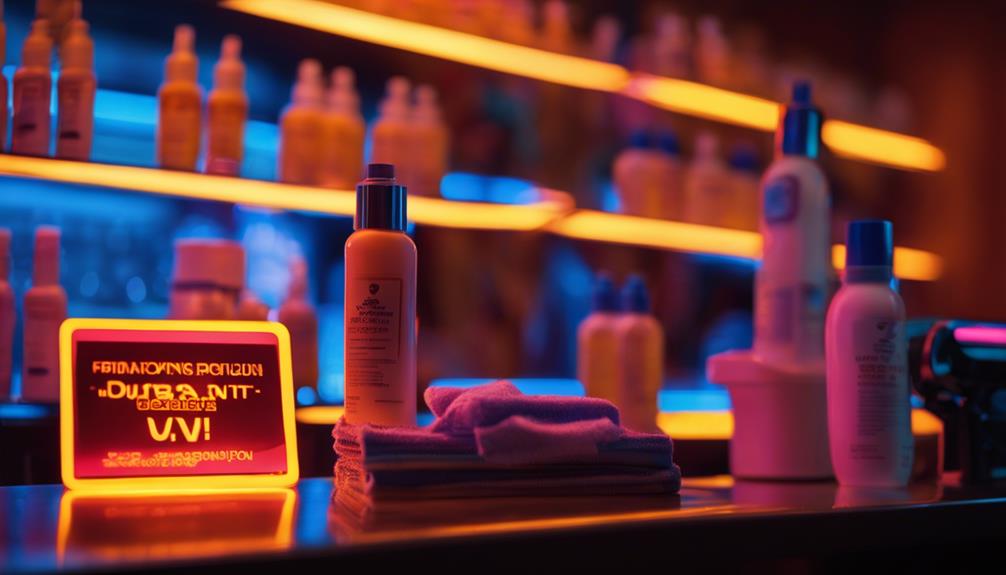Personalized tanning times are crucial for achieving a safe and effective tan that is tailored to your skin type. If you have fair skin (Type 1), it is recommended to start with just 5-10 minutes of exposure to reduce the risk of sunburn. Medium skin (Type 3) can begin with 10-20 minutes, while honey skin (Type 5) may be able to tolerate 20-30 minutes. It is important to always monitor how your skin reacts to UV light and adjust the time accordingly. Proper preparation and aftercare, such as staying hydrated and using appropriate products, can also help improve the results. By following these guidelines, you can enhance your tanning experience and achieve a healthy glow that complements your unique skin. Discover more essential tips for achieving the perfect tan.
Key Takeaways
- Fair skin (Type 1) should start tanning with 5-10 minutes to minimize sunburn risk.
- Medium skin (Type 3) can begin with 10-20 minutes, gradually increasing exposure time.
- Honey skin (Type 5) is suitable for longer sessions of 20-30 minutes, but caution is advised.
- Monitor skin reactions closely during tanning to tailor exposure durations safely.
Understanding Skin Types
Understanding skin types is essential for developing effective tanning strategies, as each type requires tailored exposure times and care to achieve the best results while minimizing the risk of damage.
Skin types range from fair (Type 1) to honey (Type 5), each possessing unique characteristics that influence tanning response.
Fair skin is particularly sensitive, necessitating shorter initial sessions, while darker skin types can tolerate longer exposure.
Individual reactions to UV light also vary, making it vital to monitor skin responses during the tanning process.
Tanning Time Recommendations
Recognizing the unique characteristics of each skin type enables the formulation of precise tanning time recommendations to guarantee effective and safe tanning practices.
It is essential to tailor exposure durations based on individual skin responses to prevent adverse effects, such as burns or uneven tanning.
- Fair skin (Type 1) should start with 5-10 minutes to minimize sunburn risk.
- Medium skin (Type 3) can safely begin with 10-20 minutes, allowing for gradual increases.
Preparing Your Skin

Effective skin preparation is essential for achieving an even and lasting tan while minimizing the risk of irritation and uneven pigmentation. Start by cleansing the skin thoroughly to remove impurities. Exfoliation is vital to eliminate dead skin cells, ensuring smooth application and absorption of tanning products. Hydrating the skin with a quality moisturizer helps maintain elasticity and prevents dryness, which can lead to flaking. Avoid heavy makeup and skincare products before tanning sessions, and always perform patch tests for new products to prevent adverse reactions.
| Step | Purpose | Tips |
|---|---|---|
| Cleanse | Removes impurities | Use a gentle cleanser |
| Exfoliate | Prepares skin for even tanning | Focus on rough areas |
| Moisturize | Maintains hydration | Choose a lightweight lotion |
| Patch Test | Prevents reactions | Test on a small skin area |
Post-Tanning Aftercare
Once the tanning session is complete, proper aftercare is essential to maintaining the tan and ensuring skin remains healthy and hydrated.
Post-tanning care involves gentle cleansing, moisturizing, and extending the tan's longevity.
Using a mild soap for cleansing prevents irritation, while applying a quality post-tanning moisturizer hydrates the skin and enhances the tan's appearance.
Additionally, consider tan extenders to prolong the glow.
- Gentle cleansing: Use mild, non-irritating cleansers to protect the skin's moisture barrier.
- Hydration: Apply a rich moisturizer immediately after tanning to lock in moisture.
These steps are vital for achieving a beautiful, healthy tan while caring for your skin.
Skin Protection Tips

Prioritizing skin protection during tanning sessions is essential to minimize the risk of damage and maintain overall skin health.
To achieve this, start with shorter tanning sessions and gradually increase exposure time based on your skin type. Hydration is key; use indoor tanning lotions to keep skin moisturized and prevent peeling.
Always wear protective eyewear to shield your eyes from harmful UV rays, reducing the risk of cataracts and long-term damage. Regular exfoliation will help maintain a smooth texture, ensuring an even tan.
Additionally, consider scheduling tanning sessions thoughtfully to avoid overexposure, allowing your skin time to recover.
These proactive measures are crucial for enjoying the tanning process while safeguarding your skin health.
Choosing the Right Products
What factors should you consider when selecting products for your tanning routine to guarantee ideal results and skin health?
Choosing the right products is essential for achieving a beautiful tan while maintaining skin integrity. Prioritize formulations that suit your skin type and desired tanning method.
- Ingredients: Look for products enriched with nourishing elements like aloe vera and vitamin E to promote hydration and skin health.
- Compatibility: Confirm products are compatible with your tanning method, whether indoor tanning lotions or sunless tanners.
Exploring Healthy Tanning Options

How can individuals achieve a sun-kissed glow while minimizing the risks associated with UV exposure?
Healthy tanning options include sunless tanning products such as lotions, sprays, and mousses. These UV-free alternatives allow users to achieve a bronzed appearance without the harmful effects of direct sun or tanning beds.
Regularly moisturizing and maintaining a proper skincare routine enhances skin texture and promotes a natural glow.
Additionally, indoor tanning options can be safer than traditional methods; however, it remains essential to tailor tanning practices based on individual skin types.
Incorporating protective measures, such as using appropriate eyewear and monitoring skin reactions, helps mitigate risks and fosters a healthier tanning experience.
Prioritizing skin health guarantees a radiant complexion without compromising safety.
Can Combination Skin Benefit from Personalized Tanning Times?
Looking for the ultimate tanning tips for combination skin? Personalized tanning times can be beneficial for this skin type. By adjusting your tanning schedule based on your skin’s needs, you can achieve a more balanced and glowing tan without over-drying your skin.
Conclusion
To sum up, the pursuit of an ideal tan, akin to the fabled golden fleece, necessitates a careful and well-informed approach tailored to individual skin types.
By adhering to personalized tanning strategies, individuals can achieve desired results while safeguarding skin health.
Just as Icarus learned from his hubris, moderation and vigilance in tanning practices are imperative to avoid potential harm.
Ultimately, the quest for a radiant glow can be fulfilled through informed choices and responsible care, ensuring both beauty and well-being.










